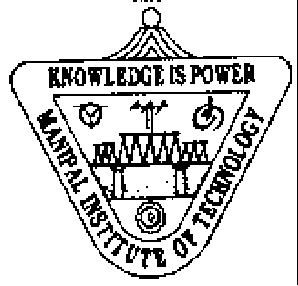Manipal University 2007 B.E Information Technology SEVENTH SEMESTER (IT) END SEMESTER MAKEUP S – , - Question Paper
SEVENTH SEMESTER B.E(IT) END SEMESTER MAKEUP exams – JAN, 2007
SUBJECT:– DISTRIBUTED SYSTEMS (ICT-403)
|
Reg.No |
Manipal Institute of Technology


(Constituent Institute of MAHE - Deemed University) Manipal - 576 104
SEVENTH SEMESTER B.E(IT) END SEMESTER MAKEUP EXAMINATIONS - JAN, 2007
SUBJECT:- DISTRIBUTED SYSTEMS (ICT-403)
(REVISED CREDIT SYSTEM)
MAX.MARKS: 50
TIME: 3 HOURS
Instructions to Candidates:
Answer any 5 FULL questions.
All questions carry equal marks.
Missing data may be suitably assumed
1 A. Define the following distributed object system related terms:
i) Remote Object Reference ii) Remote Interface 1 B. Explain the various architectures for multi-threaded architectures.
1 C. What is a distributed system? Explain heterogeneous, Resource sharing and transparency as design challenges of a distributed system
[02 + 03 + 05]
2 A. A service is implemented by several servers. Explain why resources might be transferred between them. Would it be satisfactory for clients to multicast all requests to the group of servers as a way of achieving mobility transparency for clients?
2 B. Explain the working of a LRPC. Bring out its advantages.
2 C. Write a client-server program (using JAVA API for TCP streams) to make a client send request , then receive a reply from the server. The server echoes the clients request.
[02 + 03 + 05]
3 A. What are Mobile agents? What are its use ?
3 B. Two processes P and Q are connected in a ring using two channels, and they constantly rotate a message m. At any one time, there is only one copy of m in the system. Each processs state consists of the number of times it has received m, and P sends m first. At a certain point, P has the message and its state is 101. Immediately after
sending m, P initiates the snapshot algorithm. Explain the operation of the algorithm in this case, giving the possible global state(s) reported by it.
3 C. What is a RMI and a RPC? With a relevant diagram explain the role of client and server stub procedures in RPC.
[02 + 03 + 05]
4 A. Compare connectionless (UDP) and connection-oriented (TCP) communication for the implementation of each of the following application-level or presentation-level protocols:
i) virtual terminal access (for example, Telnet);
ii) file transfer (for example, FTP);
4 B. Adapt the central server algorithm for mutual exclusion to handle the crash failure of any client (in any state), assuming that the server is correct and given a reliable failure detector. Comment on whether the resultant system is fault tolerant. What would happen if a client that possesses the token is wrongly suspected to have failed?
4 C. Explain the General architecture of distributed event notification. Bring out the use of the interfaces : RemoteEventListener and EventGenerator provided by Jini distributed event specification.
[02 + 03 + 05]
5 A. Bring out the need for marshalling and external data representation
5 B. How does the NFS Automounter help to improve the performance and scalability of NFS?
5 C. Bring out the various types of DNS queries and explain the navigation and query mechanism in DNS.
[03 + 03 + 04]
6 A. Suppose that a basic disk read can sometimes read values that are different from those written . State the type of failure exhibited by a basic disk read. Suggest how the failure may be masked in order to produce a different benign form of failure.
6 B. A client makes remote procedure calls to a server. The client takes 5 milliseconds to compute the arguments for each request, and the server takes 10 milliseconds to process each request. The local operating system processing time for each send or receive operation is 0.5 milliseconds, and the network time to transmit each request or reply message is 3 milliseconds. Marshalling or unmarshalling takes 0.5 milliseconds per message. Calculate the time taken by the client to generate and return from two requests:
(i) if it is single-threaded, and
(ii) if it has two threads that can make requests concurrently on a single processor.
You can ignore context-switching times.
6 C. With a neat sketch , explain the architecture of Sun NFS.
[02 + 03 + 05]
Page 2 of 2
|
Attachment: |
| Earning: Approval pending. |
